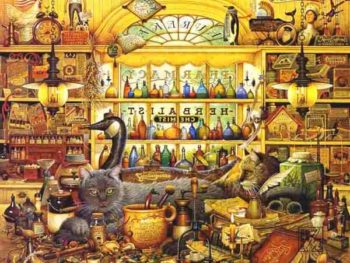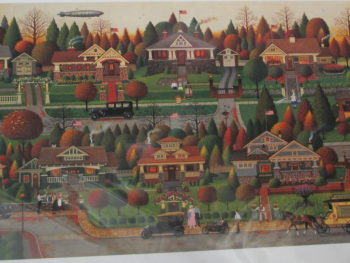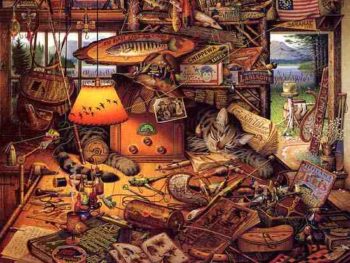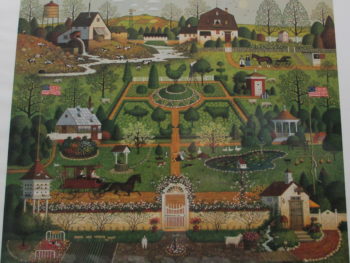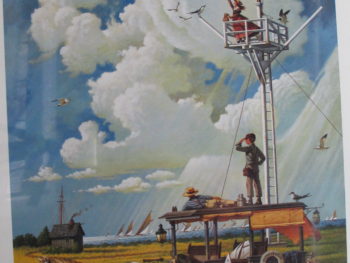[vc_row][vc_column][vc_column_text]
Charles Wysock (1928 – 2002)
The glory of America, with all its wit and wisdom, poetry and emotion, sights and sensations, is captured in the glowing, soaring, stirring, charming work of Charles Wysocki, whose unique vision and scope grows and develops as the great nation does.
When his legion of loyal fans think of his art, they think of rolling, white cumulus clouds, as well as dark, angry, stormy skies. They think of bright winter snow scenes, and crisp views of autumn. They think of happy families, as well as lonely ladies in waiting – gazing out across the foamy, rocky waters for their seagoing mates.
All this and more is the work of Charles Wysocki, one of the truly unique artists in, and of, America today. “I love this country so much,” he says. “I spent my childhood on the west side of Detroit in the Polish enclave. In our neighborhood, people still talked about the oppression they had suffered in the Old World. The freedom in America amazed them.”
That freedom infuses the work of Wysocki,who shared the longing of his family for a better life through the joys and heartaches of his images. His fine art prints and posters show a nation of splendor and aching beauty.
There’s a sense of freedom, drama, and adventure in everything he does – from the simplest still life to the most complex landscape. But never does he lose the human content. “I want to explore the whole range of emotions,” artist Charles Wysocki says. “I want drama and light, carefree times or a lonely, heartfelt memory.”
Born of Polish parents in Detroit, Charles (Chuck) Wysocki grew up in a neighborhood where much of the influence was still “foreign.” Perhaps it helped to give him perspective and a special feeling for America. His was an active and happy boyhood, with all of boyhood’s pleasures and anxieties. He remembers always wanting to draw but his parents did not share his enthusiasm for the arts, their concern for him directed toward more reliable sources of earning income. But young Charles’ interest in art continued all through high school (Cass Technical) and even through his two-year hitch with the Army.
Service duty over, Wysocki returned to the Polish community in Detroit and found a job making drawings of tools, nuts, bolts and other car parts for manuals and catalogs. It was not at all his idea of pursuing a career in the arts. Then his brother, also an artist, convinced Chuck to enroll in the Art Center in Los Angeles. Partly on the GI Bill and partly with the help of his parents, Charles Wysocki attended art school where one of his most influential teachers was Jack Potter, an illustration instructor whose twin gods were creativity and individualism.
On graduating from art school Wysocki again returned to Detroit, but two years there convinced him that he needed the sunshine of California. In Los Angeles he worked successfully, and happily, as a free-lance commercial artist for three years. He first met his wife-to-be, Elizabeth, in an advertising agency. They began dating immediately, and were married six weeks later. In the years that followed, they produced three lovely children-David, Millicent, and Matthew. They also, in the course of time, moved up into the San Bernardino mountains and made their home there.
Elizabeth was to become a very strong influence in Charles Wysocki’s life. A graduate from UCLA with the highest honors in art, Elizabeth had much in common with Chuck and was able to fully appreciate the talents of the man she had married. Her family, one of the oldest to settle the San Fernando valley, had always been farmers and she, in contrast to Chuck, had grown up in the country. Her parents welcomed the young man and he was deeply impressed with the open gentleness, the willingness to work, the cheerful unity of Elizabeth’s family. When Charles Wysocki began to evolve a style of his own in painting, he found it was linked to his sympathetic feeling for the values of simplicity and warmth that he observed in his wife’s background.
“To this day,” Wysocki says, “I feel the serenity of this life, and it became enhanced on our vacations to New England. We fell immediately in love with this section of our country because the pace so closely resembled our way of thinking – a love for the very small personal closeness of each other’s company and being content with ‘little’ things, happy in activities city folks might find boring.”
New England remains the source for many of Charles Wysocki’s favorite subjects. As for other influences, he says of himself, “I was and am probably still greatly influenced by the paintings of Rousseau, Winslow Homer, Andrew Wyeth, Edward Hopper, Ben Shahn, Norman Rockwell and, of course, Grandma Moses. But mostly, I believe, by Clara Williamson and Joseph Pickett. I do not think of myself as being either ‘folk’ or ‘primitive.’ I consider myself simply a painter of early American life with a wide mixture of influences and with a love for the old-fashioned values. If some naivete appears in my paintings, it is because I planned it that way. And that is undoubtedly because I would like to live that way myself. I feel that my relationship to older American folk and primitive art is like myself. Their simple approach to unsophisticated shapes of pattern which seem to dominate their paintings is at the same time rather abstract in quality.”
In fact, all of Charles Wysocki’s paintings are abstracts in the sense that none of them is a rendition of an actual place. Just as an author of fiction will take aspects of many people he knows and meld them into one realistic whole, so Wysocki utilizes pieces of many scenes and threads of many feelings, and weaves them into a symbolic and realistic whole. His paintings express feelings just as strongly as the imaginary scenes they depict-the quirky humor, the warmth, romance, sentimentality, the complex organization, the delight in pattern and, above all, the love he feels for America, appear again and again in his richly detailed, brilliant compositions that celebrate various aspects of American life from the early 1800s on through the 1920s and ’30s. If the scenes never existed in actuality, one has the feeling they certainly should have. Moreover, they are so rich in inventive detail that one can come back to them again and again, each time delightedly discovering something new.
Wysocki’s method of working is painstaking and methodical. When he gets a concept for a painting, he first draws the various elements on small pieces of tissue paper. There might be two or three or as many as dozens of such mini-pieces. These are moved around, or changed, or developed, or all three, until he is satisfied that he has a balanced composition. He might then do an overall drawing on tissue and then embark on color. If the color is not going properly, he will start all over again to redesign. Sometimes a painting will take weeks to develop. Sometimes all the many elements fit easily and everything seems to fall into place.
Of his painting methods Wysocki says, ‘I received most of my training as a ‘painter’ in my own studio under my own plodding direction. I took painting classes but the time spent in these classes was limited and just covered the basics. Time, and what seems like thousands of brush miles later, I still feel I have just scratched the surface. Another influence that has affected my personal style is my love for pattern. Fitting patterns together piques my interest.”
This is abundantly clear from the home in which Chuck and Elizabeth live. The house is filled with Americana-dozens of beautiful antique bottles (Elizabeth’s collection), jars, jugs, crocks, carvings of birds and other animals, textiles, lace, western bronzes, paintings, old-time artifacts, dried flowers, baskets-and unobtrusively comfortable chairs and sofas, tables and lamps in the right places. The walls are covered with original art by Wysocki and other artists, including portraits of Washington and other presidents, and – look closely! – exquisite needlepoint “paintings” done by Elizabeth. The magnificent quilt in the master bedroom is her work, too. The whole house is redolent of love and care and joy, with every nook and cranny arranged to caress the eye. To say nothing of the six cats who grace the house with their presence.
In Chuck’s studio, behind his drawing-board, is a long cabinet along one wall, lined with old tobacco tins (neither he nor Elizabeth smokes) and facing him is a wall of glass cabinets filled with a magnificent collection of art books and books on Americana of all kinds. Yet none of this gives a sense of crowding-simply of comfort and order and endless riches to delight and please, relax and stimulate. Their home, clearly as much Elizabeth’s creation as it is Chuck’s, is the joint and joyous expression of much that appears in a Wysocki painting. They join in celebrating life, and the world enjoys the gift of that celebration in the work of Charles Wysocki.
Source: http://www.swoyersart.com/charles_wysocki/
[/vc_column_text][/vc_column][/vc_row][vc_row][vc_column]
[/vc_column][/vc_row]